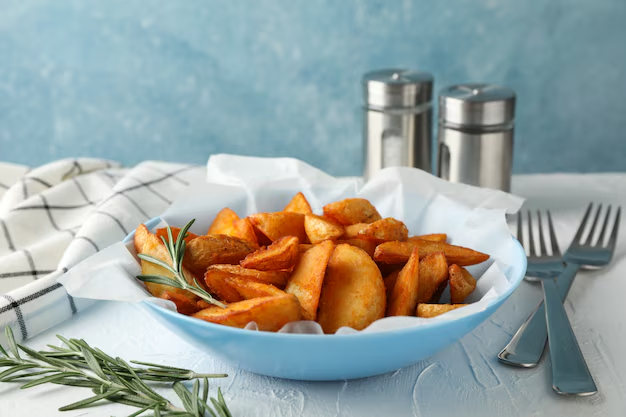Are Potatoes Better Stored in the Fridge? Discover the Optimal Way!
When you think about storing potatoes, the refrigerator might not be the first place that comes to mind. People often wonder whether keeping potatoes in the fridge is a clever kitchen hack or a culinary misstep. There’s more to this humble vegetable than meets the eye, especially when it comes to how you store it. Let’s dig into whether your potatoes should be chilling alongside your dairy and meats, or if they’re better kept at room temperature.
Understanding Potato Storage: A Balancing Act
Potatoes and Cold Temperatures: It might seem intuitive to keep vegetables fresh by refrigerating them, yet potatoes are an intriguing exception. The cool environment of a refrigerator can cause the starch in potatoes to convert into sugar. This process can result in a sweeter taste, which might not be desirable for every recipe.
Room Temperature vs. Refrigeration: Potatoes stored at room temperature generally maintain their starch content better than those kept cold. However, it’s a bit more nuanced than that. Let’s break down the impact of different storage methods on potatoes.
The Effects of Refrigeration on Potatoes
1. Sugar Content: When stored in cold conditions, such as in a refrigerator, potatoes convert more of their starch into sugar. This can result in a sweetness that might alter the intended flavor of dishes, particularly those that call for a starchier profile.
2. Texture Alterations: Cold temperatures can affect the texture of potatoes, potentially leading to a slightly grainy texture once cooked. This could be a dealbreaker for dishes that rely on creamy textures, like mashed potatoes.
3. The Cold-Induced Sweetening Dilemma: For some, the sweeter taste from refrigerated potatoes can be appealing in specific dishes, like caramelized potatoes or potato-based desserts. For others, it might throw off the flavor balance in savory recipes.
Best Practices for Storing Potatoes
If refrigeration isn’t the ideal option, what’s the best way to store potatoes for freshness and flavor?
Optimal Storage Conditions:
Cool and Dark Location: Potatoes thrive in a cool, dark environment. A pantry or a root cellar can be ideal for maintaining their quality. Aim for a temperature range of 45–50°F (7–10°C).
Ventilation is Key: Store potatoes in a breathable bag or container, such as a paper or mesh bag, allowing for proper air circulation. This helps prevent moisture accumulation and mold growth.
Avoid Sunlight: Exposure to light can lead to greening and the production of solanine, a chemical that can be harmful if consumed in high amounts.
📝 Quick Tips for Potato Storage:
- Do: Keep potatoes in a cool, dry, well-ventilated area.
- Don't: Refrigerate potatoes if you wish to maintain their starch content.
- Do: Check stored potatoes regularly and remove any that show signs of spoilage.
Exploring Related Refrigerator Topics
Not limited to potatoes, understanding food storage can transform how you manage your kitchen inventory.
1. Tomatoes and Refrigeration: Much like potatoes, tomatoes have specific storage needs. They fare better when kept out of the fridge until fully ripe.
2. Onions: Storing onions in the fridge can increase moisture which leads to quicker spoilage. Like potatoes, they prefer a cool, dark environment.
3. Bananas: Similarly, bananas aren’t ideal refrigerator candidates as the cold can disrupt their ripening process, leading to unpleasant texture changes.
Cooking with Refrigerated Potatoes: What to Expect
Should you find yourself with refrigerated potatoes, you can still find flavorful uses for them. Here’s how to make the most of potatoes that have been kept in the fridge:
- Cooking Adjustments: Adding a bit of extra seasoning can help balance out the unexpected sweetness.
- Sweet Side Dishes: Consider recipes where the sweetened flavor can be an advantage, such as roasted potatoes with honey or maple syrup.
Myths vs. Facts: Debunking Potato Storage Misconceptions
With so many opinions on refrigerator storage, it’s easy to encounter misconceptions. Here are some truths:
Myth: All vegetables belong in the fridge. Fact: Each vegetable has unique storage needs; what works for one may not be suitable for another.
Myth: Refrigerated potatoes are spoiled. Fact: They may have an altered taste or texture but are generally safe to eat unless moldy or green.
Myth: Potatoes stored in the fridge can’t be salvaged. Fact: They can still be enjoyed with slight recipe adjustments.
Common Potato Storage Mistakes to Avoid
1. Storing with Onions: Keep potatoes and onions apart, as the gases they emit can cause both to spoil faster.
2. Washing Before Storage: Moisture can promote decay, so it’s best to store potatoes unwashed and clean them just before use.
3. Overlooking Sprouts: Any sprouts or green spots should be cut away before cooking, as they may contain unhealthy compounds.
Unlocking the Potential of Proper Storage Through Expert Techniques
In the culinary world, understanding ingredient-specific storage can elevate your cooking. By mastering potato storage, you ensure an optimal balance between taste, texture, and shelf life.
🌟 Key Takeaways:
- Avoid Refrigerating: Store potatoes in cool, dark places to keep their starch content stable and maintain desired flavors.
- Be Vigilant: Regularly check potatoes for spoilage and ensure good ventilation and darkness.
- Pair with Purpose: Use refrigerated potatoes in recipes where their altered flavor profile is a benefit.
Unlocking the secrets of potato storage doesn’t just preserve the versatile spud but also empowers you to make informed decisions across your kitchen. From planning meals to shopping wisely, knowledge is your greatest tool. So the next time you unload your groceries, remember: each item has its special needs, and potatoes prefer the darkness over the cold. 🥔
